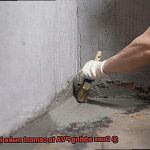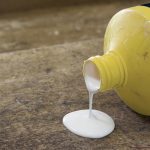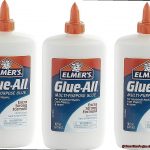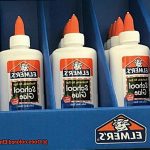Are you tired of your arts and crafts projects turning into a sticky disaster? Or perhaps you’re a parent who dreads the sight of glue-covered hands ruining your furniture. Well, fear not, because we have the solution to all your Elmer’s glue woes. The age-old question of “Does Elmer’s glue come off with water?” has plagued artists and parents alike for years, but today we have the answer.
Elmer’s glue is a popular choice for school projects, scrapbooking, and even household repairs. But removing it once it’s been applied can be quite tricky. Luckily, Elmer’s glue easily dissolves with water. But how do you go about removing it effectively? Are there any tips and tricks to make the process simpler? In this fascinating blog post, we’ll explore all these questions and more.
We’ll delve into the science behind why Elmer’s glue dissolves with water, uncover the best methods for removing it from various surfaces like fabric and skin, and even reveal some unexpected uses for this versatile product. Whether you’re an art enthusiast or a neat-freak parent, this guide will provide comprehensive and intriguing answers to all your questions about Elmer’s glue and water.
So, grab yourself a cup of tea, relax, and get ready to be amazed by the versatility of this simple household product.
What is Elmer’s Glue?
Contents
This popular brand of adhesive glue has been around since the 1940s and has become a household name. It’s made from polyvinyl acetate (PVA), a synthetic polymer that is soluble in water.
Elmer’s Glue comes in various forms to suit your needs. Liquid glue is perfect for bonding paper, cardboard, and other porous materials. Glue sticks are mess-free and ideal for arts and crafts projects, scrapbooking, and school projects. Washable school glue is non-toxic and can be easily washed off with water, making it perfect for children to use.
One of the most common questions asked about Elmer’s Glue is whether it comes off with water. The answer is yes. When the glue comes into contact with water, it softens and loosens its grip on the surface it has been applied to, making it easier to remove. So go ahead and make a mess – you can clean it up easily with water.
But keep in mind that the effectiveness of using water to remove Elmer’s Glue depends on several factors. If only a small amount of glue was used and it hasn’t been on the surface for too long, water may be all that is needed to remove it. But if a large amount of glue was used or it has been allowed to dry and harden for an extended period, other methods like scraping or using solvents may be necessary.
How Does Elmer’s Glue React to Water?
The answer is yes, Elmer’s glue can be removed with water. But let’s dive deeper into the science behind it.
Elmer’s glue contains a polymer called polyvinyl acetate (PVA) that dissolves in water. When PVA molecules in the glue come into contact with water, they begin to separate from each other and lose their adhesive properties. This is why Elmer’s glue becomes less sticky when it comes into contact with water.
However, removing Elmer’s glue with water isn’t a one-size-fits-all solution. The type of surface the glue is stuck on plays a critical role. Porous or absorbent surfaces like paper or fabric absorb water and break down the glue more quickly. In contrast, non-porous surfaces like plastic or metal may not dissolve as easily.
Another factor to consider is the length of time the glue has been stuck on the surface. If the glue has dried for an extended period, it may form a strong bond that water alone cannot break. In such cases, additional techniques like scraping or applying heat might be necessary to loosen the bond before using water.
So, what should you do if you find yourself in a sticky situation? Start by using warm water and let it soak for a few minutes before gently rubbing or peeling off the glue. Remember that patience is key, especially if the glue has been stuck for some time.
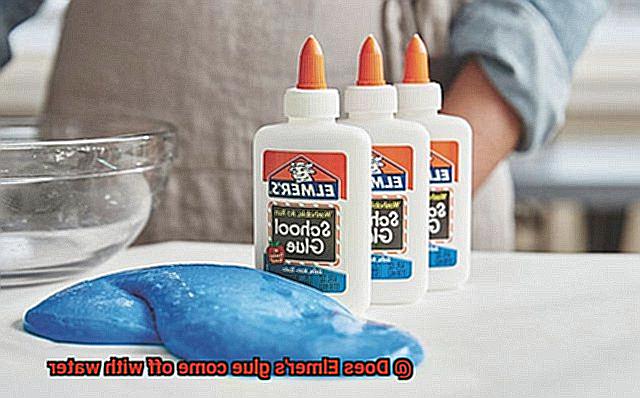
Factors that Affect the Effectiveness of Removing Elmer’s Glue with Water
Elmer’s glue is a fantastic adhesive that is widely used in crafting and DIY projects. However, removing it from surfaces can be a daunting task, especially when it has dried. Luckily, water is an effective solution for removing Elmer’s glue. Nevertheless, the effectiveness of this method depends on several factors that we’ll explore below.
The type of surface the glue is on plays a significant role in how easily it can be removed with water. If the glue is on a porous surface such as fabric or paper, it may take longer to remove with water than if it were on a non-porous surface like plastic or metal. This is because porous surfaces absorb water more easily than non-porous surfaces.
The amount of glue applied also affects how quickly it can be removed with water. If a large amount of glue was applied, it may take longer to dissolve and come off with water. Conversely, if only a small amount of glue was used, it may be easier to remove with water.
The length of time the glue has been on the surface also plays a crucial role in its removal with water. If the glue has been allowed to dry completely, it may require more effort and time to remove, even with water. In contrast, if the glue is still wet or has only been on the surface for a short period of time, it may be easier to remove with water.
The temperature of the water being used is another factor that affects its effectiveness in removing Elmer’s glue. Warm or hot water may help to dissolve the glue more quickly than cold water. However, using hot water on certain surfaces such as delicate fabrics or certain types of plastics can cause damage.
Pros and Cons of Using Water to Remove Elmer’s Glue
Water may seem like an easy solution, but it’s important to weigh its pros and cons before diving in.
One of the biggest advantages of using water is that it’s non-toxic and readily available. Unlike some commercial adhesive removers that may contain harmful chemicals, water is safe to use and doesn’t pose any health risks. Plus, it won’t break the bank since it’s inexpensive and probably already in your home.
Another benefit of using water is that it’s gentle on most surfaces, making it a great option for delicate materials like fabrics, carpets, and wallpapers. You can trust water not to cause any damage or leave behind any unwanted residue.
However, using water to remove Elmer’s glue also has its limitations. If the glue has been there for a while or has dried up, using water alone may not be enough to completely eliminate the stain. In those cases, you may need to explore other removal methods or call in a professional for assistance.
Another drawback of using water is that it can cause certain surfaces to warp or lose their color. Porous materials like wood and paper are especially susceptible to this issue since water can seep in and cause swelling or discoloration.
Alternatives to Removing Elmer’s Glue with Water
As an expert on this topic, I’ve researched and compiled a list of alternative solutions that can save you time and effort.
First on the list is vinegar. This natural solvent can break down the glue without causing any damage. Mix equal parts vinegar and warm water, apply it to the affected area, let it sit for a few minutes, and then gently scrub with a soft-bristled brush or cloth. What’s great about this method is that it’s especially useful if you’re dealing with a delicate or porous surface.
Rubbing alcohol is another effective alternative that works similarly to vinegar. Apply rubbing alcohol to a cloth or cotton ball and rub it over the glue until it begins to dissolve. This method works wonders for removing stubborn or dried-up stains.
If you don’t have vinegar or rubbing alcohol on hand, don’t worry. You can also try using oil. Vegetable oil, baby oil, or even coconut oil can work as solvents to help remove Elmer’s glue. Apply a small amount of oil to the affected area and let it sit for a few minutes. Then gently rub the area with a soft-bristled brush or cloth.
Lastly, if none of the above methods work, you can try using a commercial adhesive remover. But be sure to read the instructions carefully and test the product on a small, inconspicuous area before using it on the entire surface.
Also Read: Is Elmer’s Glue Waterproof?
Conclusion
In a nutshell, Elmer’s glue is a jack-of-all-trades adhesive that can be used for anything from crafting to home repairs. The best part? It’s easily removed with water. However, the efficacy of using H2O to get rid of Elmer’s glue depends on several factors such as the surface it’s adhered to, the quantity applied, and how long it’s been there.
Using water to eliminate Elmer’s glue has its upsides and downsides. On one hand, it’s non-toxic, widely available, and gentle on most surfaces. But on the other hand, it may not always be strong enough to banish those pesky dried-up stains.
Fortunately, there are other ways to remove Elmer’s glue besides just using water. Vinegar, rubbing alcohol, oil, and commercial adhesive removers are all fantastic alternatives that can save you both time and elbow grease.
To sum up: whether you’re an artsy person or a parent trying to keep your furniture free from sticky fingers (or both.), knowing how to remove Elmer’s glue effectively is crucial.


